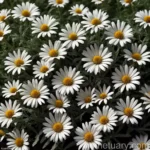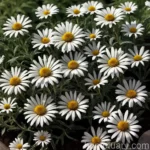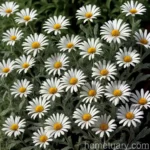The Shasta Daisy (Leucanthemum ‘Bridal Bouquet’)
Plants are an integral part of our natural environment, providing beauty, oxygen, and even sustenance. For centuries, humans have cultivated and cared for various plant species, incorporating them into our daily lives in a multitude of ways. One such plant is the Shasta daisy (Leucanthemum ‘Bridal Bouquet’), a beautiful and resilient perennial that has captured the hearts of gardeners and nature enthusiasts alike. In this comprehensive guide, we will explore everything you need to know about the Shasta daisy, from its characteristics and care requirements to its uses and potential challenges.
What is the Shasta Daisy (Leucanthemum ‘Bridal Bouquet’)?
The Shasta daisy (Leucanthemum maximum ‘Bridal Bouquet’) is a cultivar of the Leucanthemum maximum species. Belonging to the Asteraceae family, this charming perennial is known for its classic daisy-like appearance, featuring large white petals surrounding a bright yellow center. With its timeless beauty and easy-growing nature, the Shasta daisy has become a popular choice for gardens, landscapes, and even floral arrangements.
The ‘Bridal Bouquet’ variety is particularly esteemed for its prolific blooming and sturdy stems, making it an excellent addition to any garden or flower bed. Its resilience and adaptability make it suitable for various climate zones, adding to its desirability as a landscaping plant.
Key Takeaways – Shasta Daisy (Leucanthemum ‘Bridal Bouquet’)
Culture
- Hardiness Zones: The Shasta daisy is adaptable to a wide range of hardiness zones, typically thriving in Zones 4-9.
- Mature Height: It can reach a mature height of 12-24 inches, with a spread of 18-24 inches, creating a lovely, compact display in the garden.
- Blooming Season: Expect an abundant display of flowers in late spring through early summer, with intermittent blooming throughout the season.
- Attracts Pollinators: The Shasta daisy’s vibrant blooms are known to attract butterflies, making it a wonderful addition to pollinator-friendly gardens.
Uses
- Garden Beds: It serves as a beautiful addition to garden beds and borders, providing a classic, timeless appeal.
- Cut Flowers: With its long-lasting blooms and sturdy stems, the ‘Bridal Bouquet’ variety is excellent for cut flower arrangements, adding a touch of elegance to indoor spaces.
- Landscaping: Its adaptability and resilience make it a favored choice for various landscaping projects, from formal garden designs to naturalized, cottage-style settings.
Now that we’ve explored some key aspects of the Shasta daisy, let’s delve into the specifics of caring for this delightful perennial.
Shasta Daisy Care
Caring for Shasta daisies involves several key elements, including water, sunlight, fertilizer, soil, pruning, propagation, and more. By understanding and providing for these needs, you can ensure that your Shasta daisies thrive and reward you with an abundance of beautiful blooms.
Water
Proper watering is essential for the health and vitality of Shasta daisies. Here are some essential tips for watering these delightful perennials:
- Consistent Moisture: While Shasta daisies generally prefer well-draining soil, they do appreciate consistent moisture, particularly during hot and dry periods.
- Avoid Waterlogging: To prevent issues such as root rot, ensure that the soil drains well and does not become waterlogged.
- Deep, Infrequent Watering: Rather than frequent, shallow watering, aim for deep watering sessions that allow the moisture to penetrate the soil and reach the roots.
Sunlight
Like many sun-loving plants, Shasta daisies thrive in abundant sunlight. Here’s what you need to know about providing the right light conditions for these charming perennials:
- Full Sun: Shasta daisies truly thrive in full sunlight, so aim to plant them in a location where they receive at least 6-8 hours of direct sunlight per day.
- Morning Sun: If you live in a particularly hot climate, providing morning sunlight and some afternoon shade can help protect the plants from scorching heat.
Fertilizer
Fertilizing your Shasta daisies can support healthy growth and prolific blooming. Consider the following when fertilizing these lovely perennials:
- Balanced Fertilizer: Opt for a well-balanced, all-purpose fertilizer, and apply it in early spring, just as the new growth begins to emerge.
- Avoid Excessive Nitrogen: While fertilizing, be mindful of excessive nitrogen, as this can lead to lush foliage at the expense of flower production.
Soil
The right soil conditions are crucial for the overall health and vigor of Shasta daisies. Here’s what you should know about soil preferences for these charming perennials:
- Well-Draining Soil: Shasta daisies thrive in well-drained, moderately fertile soil. Amending heavy clay soil with organic matter can improve drainage and create a more hospitable environment for the plants.
- pH Levels: Aim for slightly acidic to neutral soil, with a pH range of 6.0-7.5 for optimal growth.
Pruning
Pruning can help maintain the shape and vitality of Shasta daisies, as well as encourage additional blooming. Follow these tips for effective pruning:
- Deadheading: Regular deadheading, or the removal of spent flowers, can prolong the blooming period and prevent the plant from diverting energy into seed production.
- Midsummer Pruning: In midsummer, consider cutting back the plants by a few inches to promote a more compact, tidy form and potentially trigger a second flush of blooms.
Propagation
If you wish to expand your Shasta daisy collection or share these delightful perennials with friends and family, consider propagation through division or cuttings:
- Division: In early spring or fall, carefully divide established clumps of Shasta daisies, ensuring that each division has sufficient roots and foliage to support its growth.
- Rooting Cuttings: During the growing season, you can also propagate Shasta daisies through stem cuttings, selecting healthy, non-flowering shoots for the best results.
Container Popularity
In recent years, container gardening has become increasingly popular, offering a versatile and convenient way to cultivate plants in various settings. Shasta daisies, with their charming blooms and manageable size, are well-suited to container cultivation. Here are some key points to consider when growing Shasta daisies in containers:
- Container Size: Select a container with adequate drainage holes and a size that accommodates the development of the plant’s root system. A 12- to 16-inch container is typically suitable for a single Shasta daisy plant.
- Well-Draining Soil: Use a high-quality, well-draining potting mix to support the plant’s growth and prevent waterlogging.
- Sunlight: Place the container in a location that receives ample sunlight, as Shasta daisies thrive in full sun conditions.
With proper care and attention to their specific needs, Shasta daisies can thrive in containers, adding a touch of natural beauty to patios, balconies, and other outdoor spaces.
Common Diseases
While Shasta daisies are relatively resilient, they can be susceptible to certain diseases and issues that may affect their overall health. Being aware of these common ailments can help you take proactive measures to safeguard your plants. Some of the common diseases include:
- Powdery Mildew: This fungal disease can appear as a white, powdery coating on the foliage, potentially impacting the plant’s ability to photosynthesize and thrive.
- Leaf Spot: Leaf spot diseases, caused by various fungal pathogens, can lead to the development of dark, discolored spots on the leaves, affecting the plant’s overall aesthetics and vigor.
- Root Rot: Excessive moisture and poor drainage can contribute to root rot, a condition that can lead to yellowing, wilting, and overall decline in plant health.
Disease Diagnosis
Prompt diagnosis of potential diseases is crucial for effective management and control. Keep a close eye on your Shasta daisies and be on the lookout for the following signs and symptoms:
- Foliage Changes: Any unusual discoloration, wilting, or spots on the leaves should raise concern and prompt further investigation.
- Stunted Growth: If your Shasta daisies exhibit stunted growth or a lack of vitality, consider the possibility of underlying disease issues that may be impacting their overall health.
- Root Examination: When repotting or dividing plants, carefully inspect the roots for any signs of rot or decay, which may indicate the presence of root-related diseases.
If you suspect that your Shasta daisies are experiencing disease-related issues, consider reaching out to a local horticultural extension service or professional for accurate diagnosis and tailored recommendations for treatment.
Common Pests
In addition to diseases, Shasta daisies may also be susceptible to various pests that can affect their growth and overall well-being. Some of the common pests to watch out for include:
- Aphids: These small, soft-bodied insects can congregate on the tender new growth of Shasta daisies, potentially causing distortion and damage to the foliage.
- Spider Mites: Spider mites are tiny arachnids that can infest the undersides of leaves, leading to stippling, discoloration, and a weakening of the plant.
- Slugs and Snails: These mollusks can be attracted to the tender foliage of Shasta daisies, leaving behind unsightly chew marks and potentially impacting the plant’s health.
Botanist’s Tips
As a plant scientist, here are some expert tips to help you successfully grow and care for your Shasta daisies:
- Soil Preparation: Prior to planting, take the time to prepare the soil by incorporating organic matter and ensuring proper drainage, setting the stage for healthy plant establishment.
- Regular Monitoring: Keep a watchful eye on your Shasta daisies, observing them for any signs of disease, pests, or nutrient deficiencies. Prompt intervention can help mitigate potential issues.
- Proactive Pruning: Regular deadheading and midsummer pruning can not only enhance the appearance of your Shasta daisies but also encourage prolonged blooming and overall plant vigor.
Fun Facts
Shasta daisies are not only beloved for their beauty and resilience but also for some intriguing and delightful characteristics:
- The common name “Shasta” daisy is believed to be a nod to Mount Shasta in Northern California, evoking the image of snow-capped peaks and pristine beauty.
- Shasta daisies are known for their attractive, daisy-like blooms, making them a popular choice for floral arrangements, wedding bouquets, and other decorative purposes.
Links to External Resources
To further enrich your knowledge and appreciation of Shasta daisies, here are some valuable external resources:
- The American Horticultural Society: Perennial Plant Association
- Royal Horticultural Society: Plant Care Guides
- University of California Agriculture and Natural Resources: Integrated Pest Management
From understanding the cultural needs of the Shasta daisy to recognizing potential diseases and pests, this comprehensive guide equips you with the knowledge and insights you need to cultivate and appreciate these charming perennials. Whether gracing your garden beds, containers, or cut flower arrangements, the Shasta daisy (Leucanthemum ‘Bridal Bouquet’) is sure to bring joy and beauty to your outdoor spaces. Happy gardening!
Keywords: Shasta daisy care, Leucanthemum ‘Bridal Bouquet’ plant, Shasta daisy varieties, how to grow Shasta daisies, Leucanthemum ‘Bridal Bouquet’ characteristics, Shasta daisy planting tips, Leucanthemum ‘Bridal Bouquet’ flowers, Shasta daisy maintenance, Leucanthemum ‘Bridal Bouquet’ perennial, Shasta daisy pruning, Leucanthemum ‘Bridal Bouquet’ propagation, Shasta daisy watering needs, Leucanthemum ‘Bridal Bouquet’ blooms, Shasta daisy sun requirements, Leucanthemum ‘Bridal Bouquet’ care guide, Shasta daisy soil preferences, Leucanthemum ‘Bridal Bouquet’ plant family, Shasta daisy pest control, Leucanthemum ‘Bridal Bouquet’ garden plant, Shasta daisy diseases, Leucanthemum ‘Bridal Bouquet’ growth habits, Shasta daisy benefits, Leucanthemum ‘Bridal Bouquet’ landscaping ideas, Shasta daisy companion plants, Leucanthemum ‘Bridal Bouquet’ flower arrangement, Shasta daisy container gardening, Leucanthemum ‘Bridal Bouquet’ seasonality, Shasta daisy indoor care, Leucanthemum ‘Bridal Bouquet’ water requirements, Shasta daisy pollinators, Leucanthemum ‘Bridal Bouquet’ hybrid, Shasta daisy natural habitat, Leucanthemum ‘Bridal Bouquet’ wildlife attraction, Shasta daisy medicinal uses, Leucanthemum ‘Bridal Bouquet’ garden design, Shasta daisy pruning techniques, Leucanthemum ‘Bridal Bouquet’ disease resistance, Shasta daisy winter care, Leucanthemum ‘Bridal Bouquet’ root system, Shasta daisy perennial division, Leucanthemum ‘Bridal Bouquet’ flower symbolism, Shasta daisy edible parts, Leucanthemum ‘Bridal Bouquet’ fragrance, Shasta daisy garden maintenance, Leucanthemum ‘Bridal Bouquet’ foliage color, Shasta daisy seed saving, Leucanthemum ‘Bridal Bouquet’ natural remedies, Shasta daisy landscaping benefits, Leucanthemum ‘Bridal Bouquet’ growth rate, Shasta daisy best planting time.















